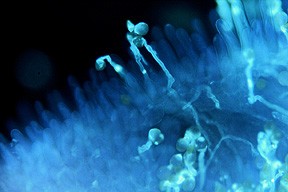Cornell researchers unlock a mystery of plant reproduction by discovering what causes pollen to be accepted or rejected
By Blaine Friedlander
Over a century ago, scientists discovered that some plants don't permit fertilization by their own pollen. And for the past quarter-century, scientists have known that cellular communication exists between the female stigma and the male gamete, or pollen, it receives. But no one knew how the stigma could tell the difference between the plant's own pollen and that from other plants.
Now, Cornell University researchers have unlocked this basic, long-standing botanical mystery in a report in the Nov. 26 edition of the journal Science. They have discovered that the answer lies in a gene that tells the stigma-based receptors which pollen to accept or reject.
Plants have several ways to reproduce. Some self-pollinate, others cross-pollinate. In the case of kale, which is a member of the crucifer family, the plant's stigma, the receptive surface at the tip of a plant's carpel, accepts only pollen from a genetically unrelated kale plant. Because kale will not fertilize itself, it is called "self-incompatible."
The fate of pollen in self-incompatible plants can be thought of as the opposite of the fate of organ transplants in animals. A transplanted organ will be rejected if its genetic makeup is different from that of the host but is more likely to be accepted if the genetic makeup is similar. In the case of self-incompatible plants, genetic relatedness between pollen and stigma results in rejection of pollen, and genetic unrelatedness results in acceptance.
The Cornell scientists, led by June and Mikhail Nasrallah, Cornell professors of plant biology, set out to learn what makes a plant self-incompatible. Almost a decade ago, the Nasrallah group identified a receptor on the surface of the stigma that allows it to distinguish between self and non-self pollen, but the label on pollen that identified it remained elusive.
In their latest research, the Nasrallahs, working with Christel Schopfer, Cornell post-doctoral researcher in plant science, found a gene located at the so-called S locus, the genomic
region that is known to control the recognition phenomenon. They called the gene "S locus cysteine-rich protein," or SCR for short. It is the long-sought-after male determinant of the crucifer plant's reproduction process. The gene holds the key to why the stigma will reject or accept certain pollen. It is expressed in the plant's anther -- the upper part of the plant's stamen -- which produces and biologically codes the pollen.
This mechanism against self-pollination is found in kale plants and other members of the crucifer family. In this particular plant family, the pollen has to be of a different mating type than the receptive stigma. If the pollen and stigma have matching mating types, as is the case in self-pollination, then the stigma prevents the pollen from fertilizing egg cells. This mating, or self-incompatibility, type is determined by that single address on the plant's genome, the S locus.
"Flowering plants have developed various mechanisms to avoid the fertilization of their ovules by their own pollen, favoring pollen grains from another plant of the same species," says Schopfer. Such cross-pollination offers the advantage of mixing genetic material, creating new and possibly advantageous gene combinations, the researchers say.
"It is a natural mechanism for producing hybrid plants -- for this family of plants, as well as other species -- on a commercial scale," says Mikhail Nasrallah.
To prove that it is the SCR gene that determines the pollen's fate on a given stigma, the Nasrallah lab transferred the SCR gene from one kale plant (a "type-A" plant) into another kale plant (a "type-B" plant.) Normally a type-A kale plant would accept the pollen from a type-B kale plant, but in this experiment, the pollen carrying the transferred SCR gene was recognized by the type-A stigma as being type-A. Thus, because of the self-incompatibility mechanism in the plant, the pollen was rejected.
The Science paper, "The Male Determinant of Self-Incompatibility in Brassica," was authored by the Nasrallahs and Schopfer. Research funding was provided by the National Science Foundation, the National Institutes of Health and the U.S. Department of Agriculture.
Media Contact
Get Cornell news delivered right to your inbox.
Subscribe
